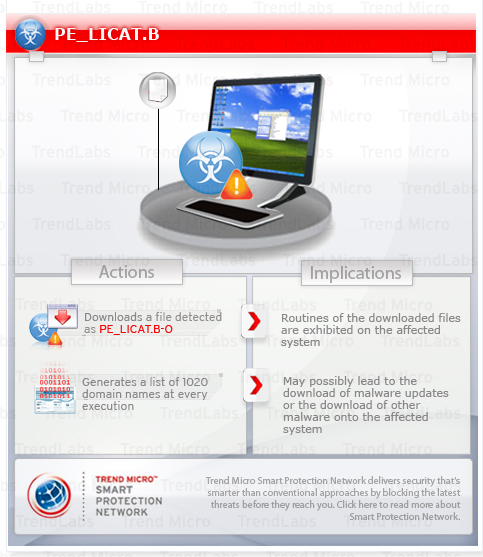PE_LICAT.B
Windows 2000, XP, Server 2003


Threat Type: File infector
Destructiveness: No
Encrypted: Yes
In the wild: Yes
OVERVIEW
Trend Micro has flagged this file infector as noteworthy due to the increased potential for damage, propagation, or both, that it possesses. Specifically, this is a new LICAT variant that uses a different key for its domain generation algorithm.
To get a one-glance comprehensive view of the behavior of this File infector, refer to the Threat Diagram shown below.

It generates a list of 1020 domain names but only attempts to connect to 800 domain names. It is capable of generating pseudorandom alpha characters using a randomizing function which is computed from the current UTC system date and time.
However, the infected files do not have the capability to infect other files.
TECHNICAL DETAILS
Varies
PE
Yes
02 Dec 2010
File Infection
This is the Trend Micro detection for files infected by:
- PE_LICAT.B-O
Download Routine
This file infector accesses the following websites to download files:
- http://{pseudorandom alpha characters}.biz/forum/
- http://{pseudorandom alpha characters}.org/forum/
- http://{pseudorandom alpha characters}.info/forum/
- http://{pseudorandom alpha characters}.net/forum/
- http://{pseudorandom alpha characters}.com/forum/
It saves the files it downloads using the following names:
- %User Temp%\{random}.TMP
(Note: %User Temp% is the current user's Temp folder, which is usually C:\Documents and Settings\{user name}\Local Settings\Temp on Windows 2000, XP, and Server 2003, or C:\Users\{user name}\AppData\Local\Temp on Windows Vista and 7.)
NOTES:
Other Details
This File infector does the following:
- Generates a list of 1020 domain names but only attempts to connect to 800 domain names.
- Infected files do not have the capability to infect other files.
- Capable of generating pseudorandom alpha characters using a randomizing function which is computed from the current UTC system date and time.
SOLUTION
8.900
7.685.80
02 Dec 2010
7.673.00
03 Dec 2010
Step 1
Before doing any scans, Windows XP, Windows Vista, and Windows 7 users must disable System Restore to allow full scanning of their computers.
Step 2
Remove the malware/grayware file dropped/downloaded by PE_LICAT.B
- PE_LICAT.B-O
Step 3
Identify and terminate files detected as PE_LICAT.B
- Windows Task Manager may not display all running processes. In this case, please use a third-party process viewer, preferably Process Explorer, to terminate the malware/grayware/spyware file. You may download the said tool here.
- If the detected file is displayed in either Windows Task Manager or Process Explorer but you cannot delete it, restart your computer in safe mode. To do this, refer to this link for the complete steps.
- If the detected file is not displayed in either Windows Task Manager or Process Explorer, continue doing the next steps.
Step 4
Scan your computer with your Trend Micro product to clean files detected as PE_LICAT.B. If the detected files have already been cleaned, deleted, or quarantined by your Trend Micro product, no further step is required. You may opt to simply delete the quarantined files. Please check this Knowledge Base page for more information.
Step 5
Search and delete this file
Did this description help? Tell us how we did.

